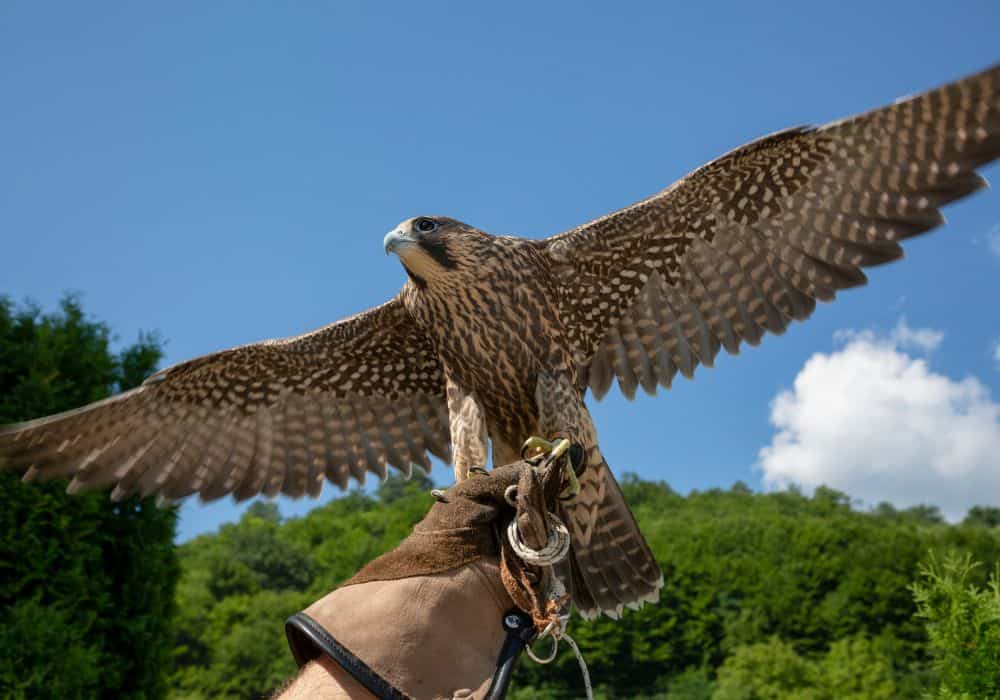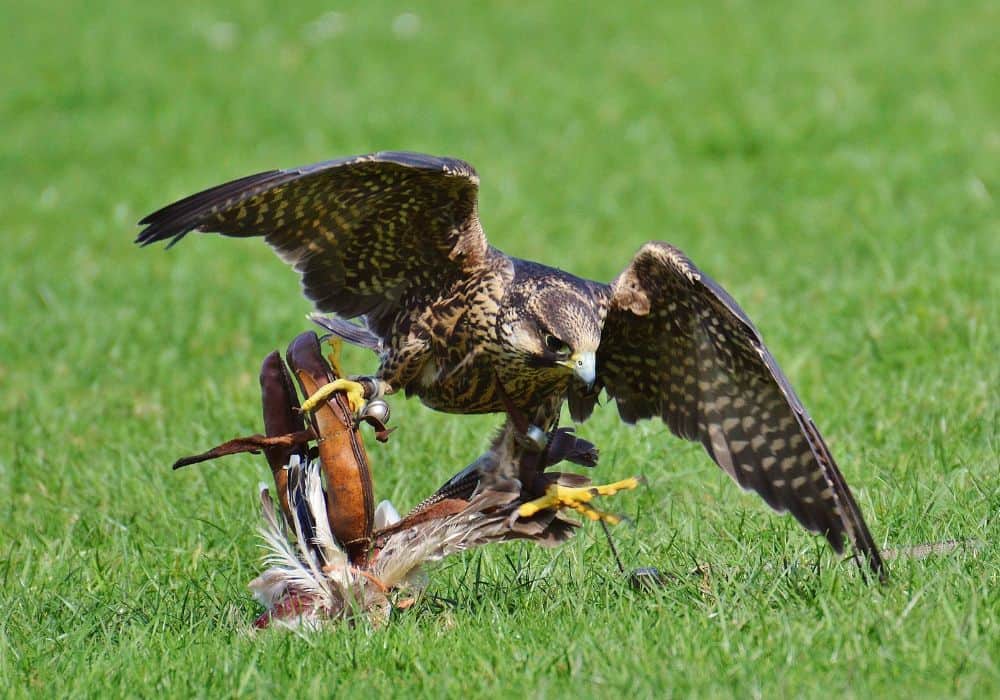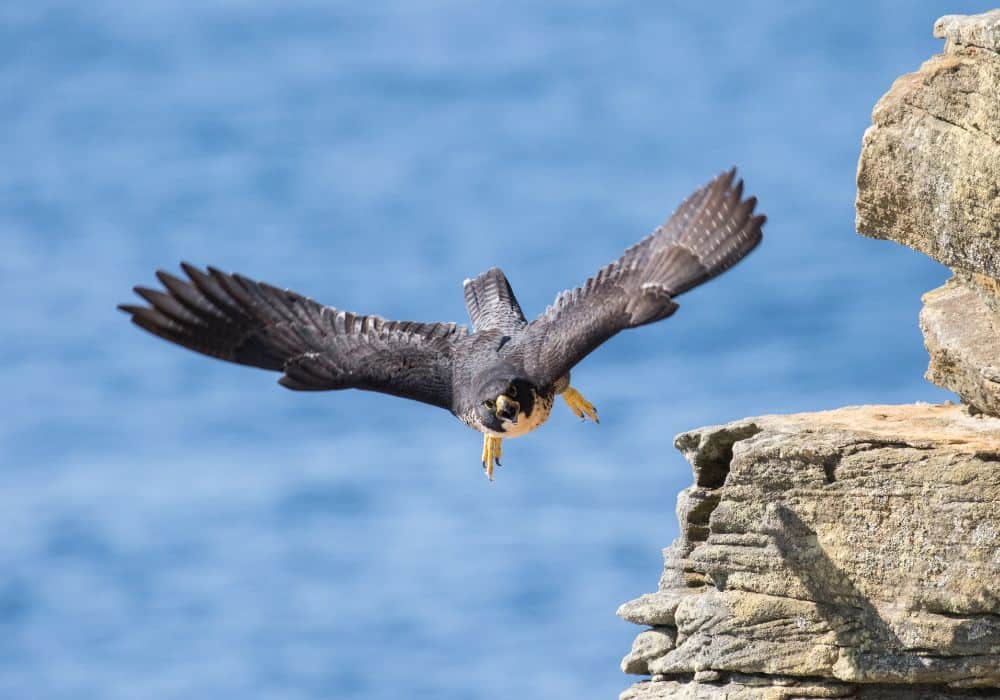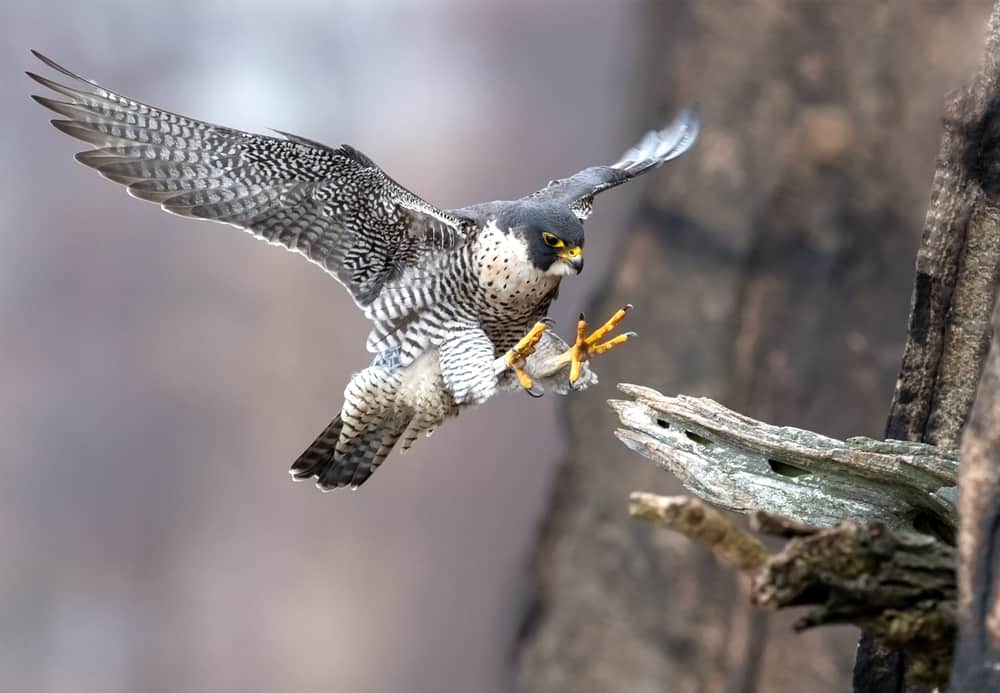Falcons are some of the most fascinating and diverse birds of prey on the earth. They inhabit every single continent except Antarctica, and yet even there the fossil record shows a population of closely-related raptors (a general term for birds of prey) existing 50 million years ago, during the Eocene.
Beautiful, hypercarnivorous, and with a history closely-tied to that of humankind, falcons are full of mystery. In this article, however, it’s our hope that we can shed at least a little light on these wonderful birds.
We’ll walk you through some key information about falcons, they and their offspring’s diets and hunting behaviors, their conservation status and place on the food chain, as well as a score of other interesting facts. Let’s get started!
What Are Falcons?

The term ‘falcon’ refers to over 40 different species of birds, spread all around the world. In short, falcons are any birds of prey in the genus ‘Falco’ (Latin for ‘hook-shaped’).
These birds can be fairly widely varied in coloring, patterning, and dietary preferences, however, being part of the one genus, they do share many similar characteristics such as sharp talons, a hooked beak with a ‘tooth’ inside, large eyes and a hypercarnivorous diet (made up of at least 70% meat).
Falcon Flight Speed
Notably, falcons are extremely fast. Adults develop exceptionally thin and tapered wings which the genus evolved in order to maneuver quickly and at sharp angles, diving and flying at staggering speeds.
Falcon chicks, on the other hand, have longer flight feathers – which resemble more the broad wings of other birds, and act like training wheels on a bike, helping the youngsters learn how to fly effectively before their wings taper as adults.
Falcon Sight
Another important falcon fact is that their eyesight is extraordinary. In fact, it is about 2.6 times more accurate than the human eye. Falcons have evolved such keen eyesight thanks to their dietary requirements (which we’ll discuss at greater length below) – they need to be able to see the smallest movements of tiny prey far, far below.
Falcon Relatives & Species
Falcons are, interestingly, not closely related to other surviving birds of prey. In fact, contrary to the incorrect claims of some popular falcon articles, they are not even closely related to birds which look like them, such as hawks and eagles. Instead, their closest living relatives are parrots and songbirds!
Within the genus Falco, there exist about 4 distinct groups of falcon species. These are: kestrels, hobbies (and their relatives), peregrine falcons (and their relatives), and – though not always considered distinct – hierofalcons (which literally means “hawk-falcons”).
Kestrels are the smallest of all falcons (the Pygmy falcon being the smallest at just 20cm long!), with the American Kestrel (AKA the “sparrow hawk“) weighing at most just 165g (5.8oz), followed by hobbies weighing up to 285g (10.1oz). Next up are the world-famous peregrine falcons, the larger females of which weigh up to 1,500g (3.3lbs). Finally, you have hierofalcons, the largest of which is the gyrfalcon (at up to 65cm long), an outsized female of which was once found in Siberia to have grown to a whopping 2,600g (5lbs 12oz)!
Here is a list of all the different falcon species, with American species highlighted in bold and underlined:
- Malagasy kestrel
- Seychelles kestrel
- Mauritius kestrel
- Spotted kestrel
- Nankeen kestrel
- Common kestrel
- Rock kestrel
- Greater kestrel
- Fox kestrel
- Lesser kestrel
- Gray kestrel
- Dickinson’s kestrel
- Banded kestrel
- Red-necked falcon
- Red-footed falcon
- Amur falcon
- Eleonora’s falcon
- Sooty falcon
- American kestrel (AKA “sparrow hawk”)
- Aplomado falcon
- Merlin (AKA “pigeon hawk”)
- Bat falcon
- Orange-breasted falcon
- Eurasian hobby
- African hobby
- Oriental hobby
- Australian hobby
- New Zealand falcon
- Brown falcon
- Gray falcon
- Black falcon
- Laggar falcon
- Saker falcon
- Gyrfalcon
- Prairie falcon
- Peregrine falcon
- Taita falcon
Falcon Sexes
Like other birds such as ducks, owls, and hawks, falcons are sexually dimorphous, meaning that males and females exhibit different physical traits. In the world of the genus Falco, this results in female falcons typically being larger than the males. Interestingly, this enables female falcons of all species to hunt bigger prey than their male partners, which may aid considerably in the feeding and rearing of their young.
Falcon Habitat
Falcons are spread all around the world, and as such their preferred habitats vary considerably. Generally speaking, however, falcons prefer to live close to optimal hunting grounds, since their diets consist exclusively of meat.
Some falcon species, such as the kestrels, are migratory birds, and may range as far as from Alaska to South America. Others, however, such as the peregrine falcon, are more random roamers, going where their prey is most bountiful, but without clear migratory patterns.
Falcon Nesting
As with habitat, the nesting behaviors of falcons vary greatly among all the different species around the globe. Peregrine falcons, who can often be sighted near bodies of water such as by the sea, tend to build their nests (called ‘eyries’) high up on cliff ledges. Whereas other falcons, such as the New Zealand falcon, will construct their nests in tall grasses.
What Do Falcons Eat?

All falcons, as birds of prey, are what is known as “hypercarnivorous”. This means that, like other carnivores such as lions, tigers, sharks and so forth, they actively hunt smaller prey as their sole means of nutrition. To put it in other words, a falcon’s diet consists of meat, and meat only!
Where this gets complicated is in the sheer number of different species of falcon. Since the gyrfalcon can weigh up to 2,600g (5lbs 12oz), and a pygmy falcon just 54g (1.9oz!), they naturally cannot hunt the same animals.
As such, the diets of falcons vary widely throughout the Falco genus, depending on several factors including species size, habitat, and geographical location. Having said that, falcon diets on average are comprised of 77-99% other, smaller birds.
Smaller falcon species tend to prefer the following:
- Grasshoppers
- Crickets
- Moths
- Beetles
- Other small insects
- Small reptiles
- Small birds (during the winter, when insects and flies are less abundant)
Medium-sized birds in the Falco genus, in addition to small birds, like to snack on these tasty treats:
- Voles
- Squirrels
- Lemmings
- Hummingbirds
- Mice
- Rabbits
- Rats
- Gophers
- Small snakes
- Frogs
- Other small mammals
- Other small animals
Large falcons almost exclusively prey on other birds, and are not picky about which ones! However, these are some of the birds which large falcons like the gyrfalcon and peregrine falcons eat:
- Waterfowl
- Starlings
- Shorebirds
- Jays
- Gulls
- Pigeon
- Doves
- Grebes
- The eggs of bigger birds, like Sandhill Cranes
What Do Baby Falcons Eat?
Baby falcons, called chicks or eyas (also spelled eyass), are raised by their parents on the exact same diet as the moms and pops! Just like every other bird, falcon eyasses have to stay in the nest and be nurtured by their parents (often just the female parent) until they are grown large and strong enough to fledge the nest and begin hunting for themselves
When they are newly-hatched, eyasses have to be fed by the mother. Unlike other birds you may have seen feeding their chicks – via partial digestion and regurgitation – falcons instead take their captured prey to the nest, and there tear it into bite-sized chunks for their babies to eat.
When falcon eyasses reach around 6-weeks old, they are grown strong and agile enough to begin tearing pieces of meat from their mother’s prey for themselves. At this point, the mother will simply toss the prey whole directly into the nest.
Fledglings are typically ready to leave the nest (in a process called ‘fledging’) at around 42-46 days after hatching, but again, it must be said that this may differ depending on the specific falcon species.
How Much Do Falcons Eat?
Falcons get all of their nutrients through the meat they eat, and the prey they hunt. As such, they do have to eat a fair bit to keep them going.
As a good guideline, note that kestrels (remember, they are the smallest of all falcon species) have to eat around 21% of their body weight every single day (for a kestrel, this equates to about 3.5-5.3oz). Can you imagine having to do that? An adult male human, after all, eats around just 0.5% of their body weight each day!
On the other hand, larger species of falcon such as the peregrine falcon must east around 70g of food each day, or about two average-sized blackbirds. If adult female peregrines can grow to 1,500g, then this diet equates to less than 0.05% of their body weight!
As you can see, the difference between how much different falcon species eat is stark, from 0.05% to 21% of their body weight per day!
How Often Do Falcons Eat?
Falcons spend a great deal of their time each day hunting for their food. The life of many of the world’s predators is spent like this. If, in fact, you are lucky enough to spot a falcon, then you are almost guaranteed to find it in the act of looking for food.
Searching for food is a huge part of a falcon’s day, whereas successfully catching prey will form but a few brief moments of it. Equally, falcons – though highly adept predators – are not always successful in their predation.
A study into the success rates of Peregrine falcons hunting Dunlin in winter, for example, found that these birds of prey may only catch their meals 7% of the time; though this rate can reach as high as 83% in certain situations.
In essence, a falcon eats as often as it can, until it can eat no longer, or can find no more prey to stalk.
How Do Falcons Hunt?
The one aspect to their hunting techniques which all falcons share, and which differentiates them from other birds of prey like eagles and hawks, is the fact that they kill not with their sharp talons, but with a ‘tooth’-like barb in their beaks.
This, however, is where the similarities stop. Different falcons hunt in lots of different ways.
For example, Pygmy falcons perch atop branches of brush in African shrublands and keep their eyes peeled for small insects, lizards, mammals and other reptiles.
Kestrels and many species of hobby falcons, on the other hand, appear to ‘float’ on the wind. In fact, they gliding with their wings out, countering the headwinds at exact speeds so as to stay perfectly in place, with their stabilized in place. They keep their eyes toward the ground in search of prey, before diving and swooping on the unsuspecting animals.
Peregrine falcons have perhaps the most famous of all the hunting techniques. They are, believe it or not, the fastest animal on the planet. As such, they employ two different hunting techniques to great effect: the chase, and the dive (a specialist dive which is known as ‘stooping’).
Peregrines prefer the stoop, as is gives them the advantageous element of surprise. When stooping, peregrines fly up really high and circle, their heads pointed down, looking for prey.
Once they’ve found the bird (usually a pigeon) which they want to kill, they fold their wings in beside their bodies and dive. Using this technique, peregrine falcons can achieve speeds of up to 242mph (nearly 390km/h)! Prey rarely see birds this fast coming.
Do Falcons Have Predators?

Even though falcons are some of the most successful hunters in the world, this doesn’t put them at the top of the food chain.
Some of the smaller species of falcon are in fact hunted by larger species, like the gyrfalcon, as well as by other birds of prey like eagles and great horned owls.
Falcon chicks, as well as adult falcons feeding on the ground, are occasionally preyed upon by larger mammalian predators such as wolves.
Unfortunately, one of the biggest ‘predators’ of falcons remains… us. Humans. Through hunting, habitat destruction, deforestation, urban expansion and other elements of our contribution to the ongoing climate crisis, falcons face ever harder living conditions thanks to us.
Conclusion
There are over 40 different species of falcon spread out all over the world. They all eat an exclusively meat-based diet, accessed through hunting, which they do using a variety of different techniques specialised to suit their size, dietary preferences, habitat and prey.
FAQs
Do people keep falcons as pets?
Falcons are not domesticated animals, but humans have a long history of keeping them as, not so much ‘pets’, but working animals. For at least 4,000 years, since the time of Ancient Egypt, we have been training falcons to hunt for us.
The art of hunting with Falco genus birds of prey is called ‘falconry’ and was especially common in the upper-classes and nobility of the medieval era in Europe, though has been practiced to some extent in almost every part of the world.
Can falcons pick up cats?
Don’t worry, your cat is safe from falcons! The vast majority of falcons ae simply too small to even try and pick up a cat, though larger hierofalcons like the gyrfalcon technically could. The only time when a cat might be at risk of predation by a falcon is when they are a kitten, or if they were particularly weak and small. Generally, however, we’d say: don’t worry!
How do peregrine falcons dive so fast?
Peregrine falcons can reach speeds of up to 240mph (or around 390km/h), which begs the question: how? The answer is simple but extraordinary: their bodies have evolved in ways no other animals’ have.
The pressure of diving at these speeds should crush the lungs of peregrines, but they do not. This is due to specialised ‘baffles’ inside peregrine nostrils which filter in only the air they need. Crazily, jet fighter engines were actually designed to mimic the peregrine falcon’s anatomy!
